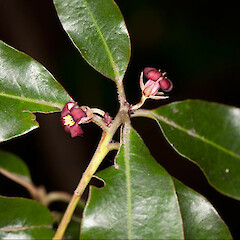Pittosporum huttonianum
Common name
Hutton’s kōhūhū
Synonyms
Pittosporum huttonianum Kirk var. huttonianum, Pittosporum huttonianum var. fasciatum Kirk
Family
Pittosporaceae
Flora category
Vascular – Native
Endemic taxon
Yes
Endemic genus
No
Endemic family
No
Structural class
Trees & Shrubs - Dicotyledons
NVS code
The National Vegetation Survey (NVS) Databank is a physical archive and electronic databank containing records of over 94,000 vegetation survey plots - including data from over 19,000 permanent plots. NVS maintains a standard set of species code abbreviations that correspond to standard scientific plant names from the Ngä Tipu o Aotearoa - New Zealand Plants database.
PITHUT
Chromosome number
2n = 24
Current conservation status
The conservation status of all known New Zealand vascular plant taxa at the rank of species and below were reassessed in 2017 using the New Zealand Threat Classification System (NZTCS) – more information about this can be found on the NZTCS website. This report includes a statistical summary and brief notes on changes since 2012 and replaces all previous NZTCS lists for vascular plants.
Please note, threat classifications are often suggested by authors when publications fall between NZTCS assessment periods – an interim threat classification status has not been assessed by the NZTCS panel.
- Conservation status of New Zealand indigenous vascular plants, 2017 . 2018. Peter J. de Lange, Jeremy R. Rolfe, John W. Barkla, Shannel P. Courtney, Paul D. Champion, Leon R. Perrie, Sarah M. Beadel, Kerry A. Ford, Ilse Breitwieser, Ines Schönberger, Rowan Hindmarsh-Walls, Peter B. Heenan and Kate Ladley. Department of Conservation. Source: NZTCS and licensed by DOC for reuse under the Creative Commons Attribution 4.0 International licence.
2017 | At Risk – Naturally Uncommon
Previous conservation statuses
2012 | At Risk – Naturally Uncommon
2009 | Not Threatened
2004 | Not Threatened
Brief description
Small tree with silvery fuzzy young parts and dark green shiny leathery leaves that are paler underneath and 1.5-2cm wide capsules. Flowers red, with silvery fuzzy base. fruit splitting into three to show the black seeds in a yellowish pith.
Distribution
Endemic. North Island, Great Barrier Island, and the Coromandel Peninsula to about the Karangahake Gorge in the east. Also present from Te Akau south to about the Tawaroa Forest in the western Waikato.
Habitat
Coastal to lower montane (1-700 m a.s.l.). Common in regenerating forest, or along ridge lines, on cliff tops, along slip scars, rock tors and in limestone country fringing razorbacks and dolines (tomo) shafts. Rarely as a sparse understorey component of mature forest.
Detailed description
Gynodioecious, small, broad crowned trees up to 10 m tall. Trunk stout, grey-balck to brown, lenticillate. Branches spreading. Branchlets dark brown, at first covered with floccose white, white-grey to faintly fulvous tomentum, glabrate. leaves alternate, crowded toward branchlet apices. Petioles 5-15 x 1-3 mm, at first covered with appressed white tomentum, soon glabrate. Leaf buds copiously covered with white, white-grey or faintly fulvous tomentum. Lamina 40-120 x 20-60 mm, dark green above paler beneath, elliptic-oblong, obovate-oblong, apex and base acute to obtuse, margins entire, undulate or revolute emergent leaves copiously covered with white, floccose tomentum, soon glabrate. Flowers terminal, axillary or soliatry, usually in (1-)2-4-flowered fascicles; pedicels up to 20 mm long, accrescent in fruit, white-tomentose, usually subtended by 1 or more cataphylls and 2-10 mm long, caducous, tomentulose or glabrous bud scales. Sepals 6-9 x 2-3 mm, oblong, acute, outer surface covered with floccose white tomentum, inner glabrous. Petals 12-18 x 3-4.5 mm, red, margenta, purple or white, oblanceolate, linear-oblanceolate, obtuse to subacute, free from base, recurved from about the middle; stamens 6-10 mm, anthers 1.5-4.5 x 0.8-1.5 mm. Ovary 2.5-5 x 1-3.5 mm, copiously white-tomentose; style 2-5.5. mm long, stigma capitate or truncate. Capsules 12-20 mm diameter, (2-)3-valved, trigonous, apiculate, coriaceous to woody, at first white-tomentose soon glabrate, somewhat rugose. Mucilage orange to orange-red. Seeds 16-25, reddish-black to black, of irregular shape.
Similar taxa
By and large a well marked species, distinguished from other New Zealand large-leaved Pittosporum by the elliptic-oblong, obovate-oblong leaves, and capsules which are initially rather generously covered in distinctive white to fulvous floccose tomentum. However, it grades into P. ellipticum around the Karangahake Gorge, where the chief distinction is the presence (sparsely in this area) of floccose white - fulvous rather than rust-brown tomentum. In the western Waikato it appears to grade into P. colensoi Hook.f., from which, again the chief difference is the copious floccose tomentum, which is otherwise absent in the sparsely hairy leaves of P. tenuifolium subsp. colensoi. Also the latter entity is a more upright tree, while P. huttonianum tends to have a broader, more spreading crown. In some areas the distinction is rather arbitrary caused perhaps by hybridism. Further study into the matter is desired.
Flowering
October - November
Flower colours
Red/Pink, Violet/Purple
Fruiting
November - October (fruit present throughout the year)
Propagation technique
Easily grown from fresh seed. An attractive small tree for a small garden. Rather tolerant of a range of conditions.
Etymology
pittosporum: Pitch seed
Taxonomic Notes
In parts of its range this species appears to grade with P. colensoi and P. tenuifolium. Many botanists informally regard P. huttonianum as a subspecies of P. tenuifolium. Further research into its status, perhaps by using an appropriate range of molecular markers might clarify it status. NZPCN retain the species because for most of its range it is a well marked species and in that range it is often sympatric with P. tenuifolium.
Attribution
Fact sheet prepared for NZPCN by P.J. de Lange 30 August 2006. Description adapted from Cooper (1956).
References and further reading
Cooper, R.C. 1956: The Australian and New Zealand species of Pittosporum. Annals of the Missouri Botanical Garden 43: 87-188
NZPCN Fact Sheet citation
Please cite as: de Lange, P.J. (Year at time of access): Pittosporum huttonianum Fact Sheet (content continuously updated). New Zealand Plant Conservation Network. https://www.nzpcn.org.nz/flora/species/pittosporum-huttonianum/ (Date website was queried)






